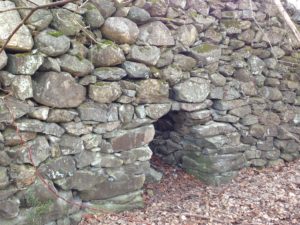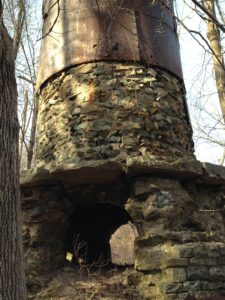
2:00-4:00 pm, February 25, 2018
Exhibit at BVHS
Downstairs at North Gate
1873 Old Louisquisset Pike
Lincoln, RI 02865
Note: There will also be special exhibits from the collections of Jim and Dan Bethel.
If you live in Lime Rock, you may be familiar with these mysterious stone structures. But maybe not. Most of them are hard to see, even though you may drive past them often. This exhibit will walk through seven sites that are part of Lime Rock’s history. Mining and processing lime was nearly a continuous industry in Lime Rock from 17th century until nearly the 21st century (the Conklin Lime Quarry). These stone kilns, which bear a strong resemblance to ones in England, are relics of this early industry.
Our original idea was to do a walking tour, but most of the locations aren’t very accessible.

Lime deposits were discovered in Rhode Island very early in the colony’s history. Although limestone was found what is now Johnston, North Providence, and Cumberland, the largest deposits were in Lime Rock, which was then part of the Providence territory and referred to as the “North Woods” or the “Outlands.” In 1730, it became Smithfield. At some point between 1662 and 1669, Thomas Harris and Gregory Dexter each gained possession of land in the Lime Rock area containing limestone deposits and shortly afterwards began to work them. There is a letter dated August 19, 1669 from Roger Williams to the governor of Connecticut, John Winthrop Jr, introducing Gregory Dexter to his notice as a producer of lime. Descendants of Thomas Harris and Gregory Dexter dominated the lime business until the early 20th century. The Harris Lime Rock Company was incorporated in 1823, and the Dexter Lime Rock Company was incorporated in 1854, and they later merged. The Whipples, Jenckes, and Arnolds were also involved in the business of producing lime.
Many of the residents of Lime Rock worked part or full-time mining lime and burning it in the kilns, or in related work such as woodcutting, charcoal burning, and making barrels to hold the finished lime. Elaborate leases of rights to dig lime and burn it were drawn up. It was additional income for many farmers. “Smithfield” lime was marketed up and down the east coast, and was considered very fine. Expediting the shipment of lime to Providence was one of the principal reasons for the building of the Louisquisset Pike. It was such a big business that a bank was needed, and the Smithfield Lime Rock Bank was founded in 1823.

Lime was very valuable in colonial times. It was chiefly used for mortar and plaster for building. The “stone ender” chimneys at the Eleazer Arnold House and the Valentine Whitman house were built using local lime. It was also used in tanning, bleaching, blacksmithing, sugar refining, and candle making. Later it was used as a soil amendment, as it is used today. In the late nineteenth century, Portland cement took the place of natural lime mortar in building. Before the discovery of limestone, the early colonists made lime by burning seashells, which was inferior for building.